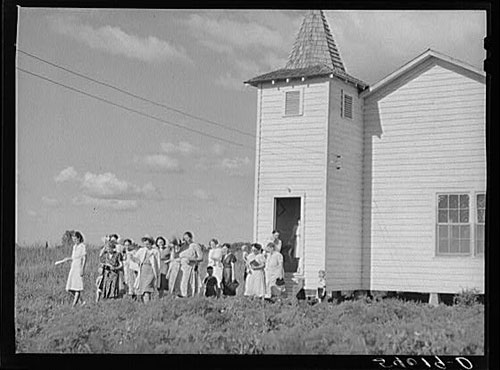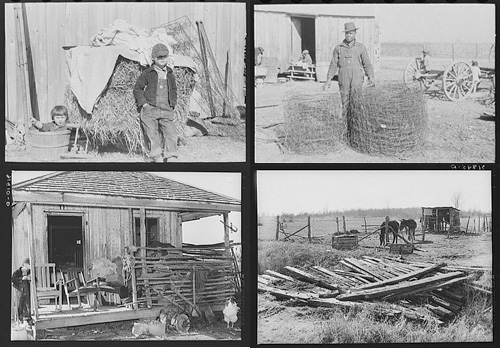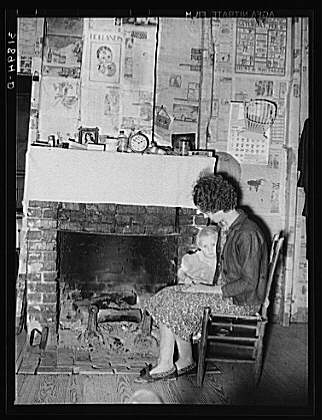| home | pg. 1 | pg. 2 | pg. 3 | pg. 4 | pg. 5 | pg. 6 | pg. 7 | pg. 8 | pg. 9 | pg. 10 | pg. 11 | pg. 12 | pg. 13 | pg. 14 | pg. 15 | pg. 16 | pg. 17 | notes | Transylvania detail 1 | Transylvania detail 2 | Wolcott detail | Bibliography | D. Gorton Homepage | Jane Adams Homepage
|
|
Reading the Photographic Record
by
Jane Adams
D. Gorton
|
We recently read the memoir of John H. Scott, the man who had mobilized the protest that reached President Roosevelt's desk and the story became clearer.[9] Transylvania had been a black settlement created after the Civil War. Through various processes the land became owned by a Memphis company and rarely if ever visited these holdings. The farmers built a church, had a Rosenwald school, and buried their loved ones in a cemetery. In 1939 the FSA acquired the property and planned to remove all the blacks and re-settle the plantation with white tenant farmers selected by the FSA. |
 The women's club leaving the church and community building after a home management demonstration by the supervisor and a baby shower they gave for Mrs. Verden Lee, one of their members. Transylvania Project, Louisiana. Marion Post Wolcott, June 1940 . LC-USF34- 054019-D [Wolcott was apparently not aware that this had been the first black Baptist church in the parish, which was appropriated by the FSA when they settled white sharecroppers on the former plantation.] |
| The black tenants resisted, recruiting the NAACP and other powerful allies. For reasons that remain obscure – but potentially knowable as our research continues – the project moved forward. Eventually, on that bitter January day captured so enigmatically by Russell Lee, people were evicted from their homes. |
 Photos by Russell Lee, January 1939. Top to bottom, Left to Right: |
| The displaced blacks got a sop, however, at least as Scott tells it: three other projects on which all the qualified families were resettled. One was at the south end of East Carroll Parish, adjoining Transylvania but on poorer land, called Henderson. One was at Thomastown to the south. And the third was called Lakeview, to the north and across the lake from the town of Lake Providence. |  Wife and daughter of FSA (Farm Security Administration) client in front of fireplace of temporary home. Transylvania, Louisiana. Russell Lee, January 1939. LC-USF34-031894-D Wife and daughter of FSA (Farm Security Administration) client in front of fireplace of temporary home. Transylvania, Louisiana. Russell Lee, January 1939. LC-USF34-031894-D |
| home | pg. 1 | pg. 2 | pg. 3 | pg. 4 | pg. 5 | pg. 6 | pg. 7 | pg. 8 | pg. 9 | pg. 10 | pg. 11 | pg. 12 | pg. 13 | pg. 14 | pg. 15 | pg. 16 | pg. 17 | notes | Bibliography | Transylvania detail 1 | Transylvania detail 2 | Wolcott detail |
|
|